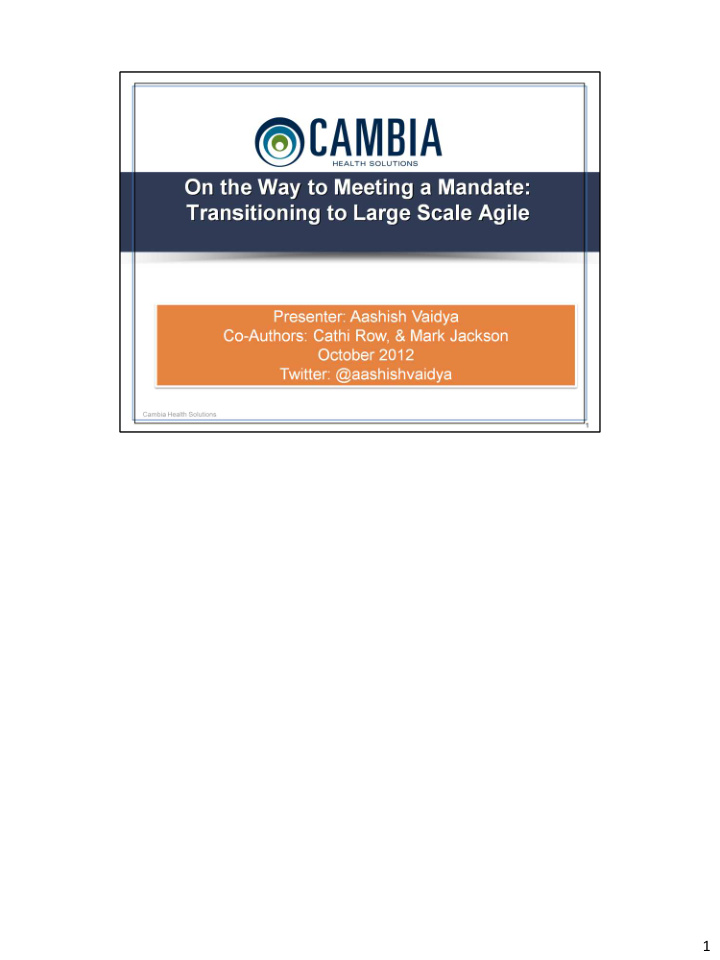



1
• Survey the audience on their IT or Engineering department size. • Where are they in the Agile adoption cycle? 2
3
Silos with Architecture, Analysis, Application Development, Release and QA and Infrastructure 4
5
6
• June 2011 – we re-organized into IT groups that were aligned with business units • We decided to transition all of IT to use Agile as our primary SDLC process • Goals still remained the same, but we hoped we can better realize them through this structural change in organization and SDLC 7
Part of the transition, we restructured teams in cross-functional agile team 8
• Work in the enterprise comes in many forms: Projects, Enhancement Requests, Break-Fix work. • Each team maintains its own backlog containing any form of enterprise work. • Work is pulled down by the team 9
• Agile Teams are organized cross-functionally. • Best Practices Exchanges or Communities are organized across agile teams • BPEs or Communities can have role or function specific focus • Examples: Enterprise Transition Community, Agile BPE, Software Quality BPE, Agile Coaching Community, Agile Training Community, Product Owner Community. 10
• Resistance or fear of Change – we have always done it this way, we are afraid to change • Jaded individuals who have seen these type of large scale efforts come and go • Team Makeup – not all teams have the right skills • Skepticism on agile method • Lack of knowledge agile techniques 11
From patch work Agile adoption to an Enterprise wide rollout. Includes 600 IT members as well as another 300-400 affiliated team members from other business units. 12
• As technologists – we pay scant attention to the personal dimension of change • Motivation – will it be worth it? • Ability – can I do what is required • Both dimension have to be addressed at personal, social and structural level Couple of examples on how we tapped into these influencer sources: - Provided agile training programs. Provided internal agile coaches for ongoing support. - Formed user communities, BPEs to harness peer pressure as well as find strength in numbers - At structural level, asks teams to co-locate if possible (or at least co-locate for sprint planning, release planning activities) 13
Makeup of ETC and other BPEs has to be representative of various groups we are asking to transition. We gained more traction on the transition with various other non-IT business units, when we added ETC members from their ranks. 14
• ETC and other BPEs must eat their own “dog” food. • ETC follows scrum • We have daily scrums, demos with CIO staff and other senior management, conduct retrospectives, do release planning and create 4 quarters rolling roadmap • Here is an actual velocity chart 15
16 16 16 16 16
• Team members are not dedicated and we poll for capacity every sprint • Large challenge – one remedy could be that the organization can institute 20% flex time like Google or 2 weeks Paid Time On like Salesforce.com, where individuals go and spend part of their time on what Mike Cohn calls “Improvement Communities”. • Communities that are thriving are the ones where a core group of individuals are committed 17
• Large scale transitions require training plans tailored to individuals and their roles. • Tapping into Organizational Development function within HR group is recommended. • Peer learning through Best Practices Communities is also powerful. This is a self- development opportunity for many. Also, these type of training is generally well- received as peers find it contextual, relevant and relatable. 18
Insisting on getting a PO from the business unit for every agile team was painful but very useful. The on-going conversation is allowing us catch issues faster. IT is able to push back on the business by insisting that they do prioritization. Allows business units to own the prioritization so they feel in control. Again, all the benefits you expect to achieve from this methodology. The UAT folks took the opportunity to assign SMEs and testers to each of the teams. This allowed us to get better at defining uncovered requirements through building out better acceptance criteria. 19
Team Scorecard – drove shoring up the team as a unit 20
Snapshot of Agile Team Composition Scorecard in March, 2012. Note the reds and yellows. 21
Snapshot of Agile Team Composition Scorecard in September, 2012. Note more greens, as the organization collectively created action plan to improve shortcomings. 22
Four categories of metrics. 23
Introduce your metrics iteratively if you can. This allows teams to digest the metrics and if they fall short, they are doing something about it. If you do too much, teams will be overwhelmed. 24
Definition of Mission metrics 25
26
The Enterprise Transition Community’s focus, initially has been on forming agile teams and providing support. Moving forward, the concentration has been driving large scale agile into the enterprise. There are many practices that we have been introduced. However, it was beyond the scope of the current paper to talk about many of these activities. We hope to bring an update on this front next year. 27
28
Recommend
More recommend